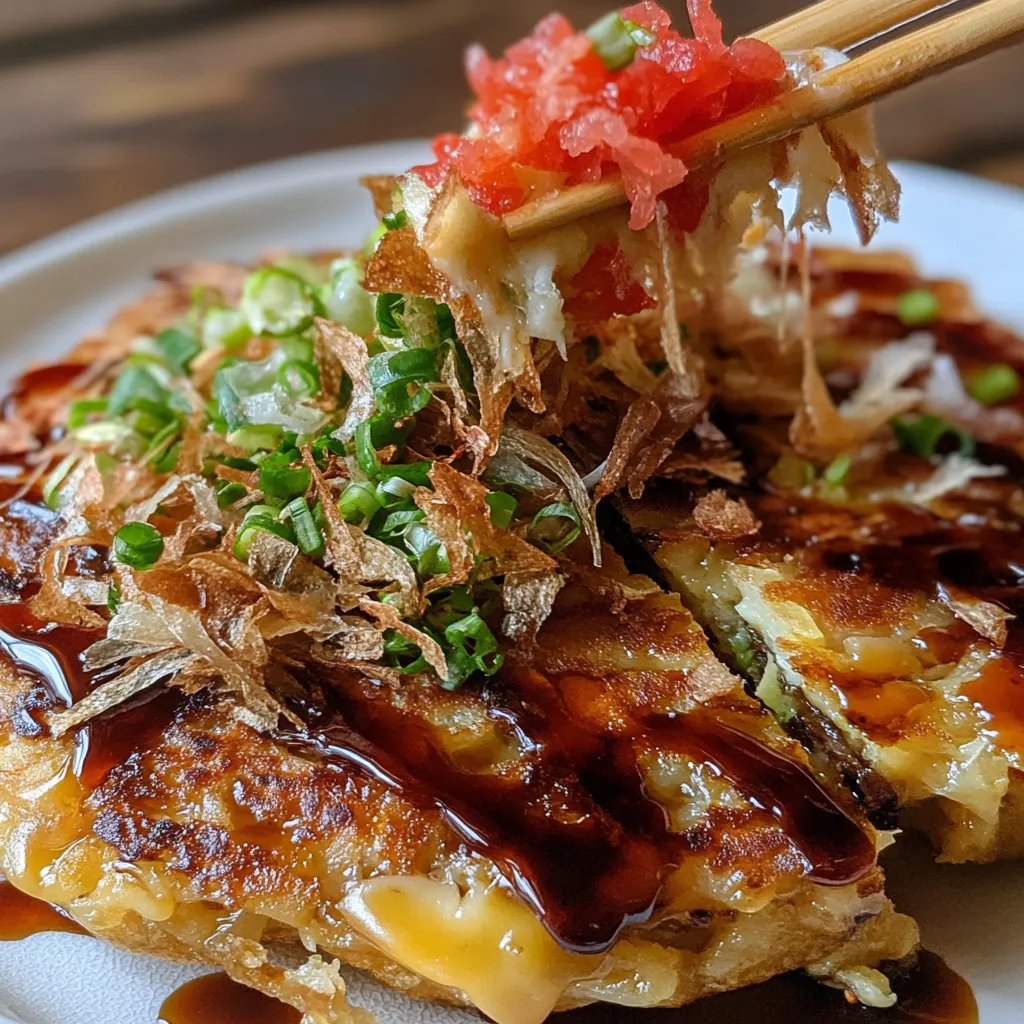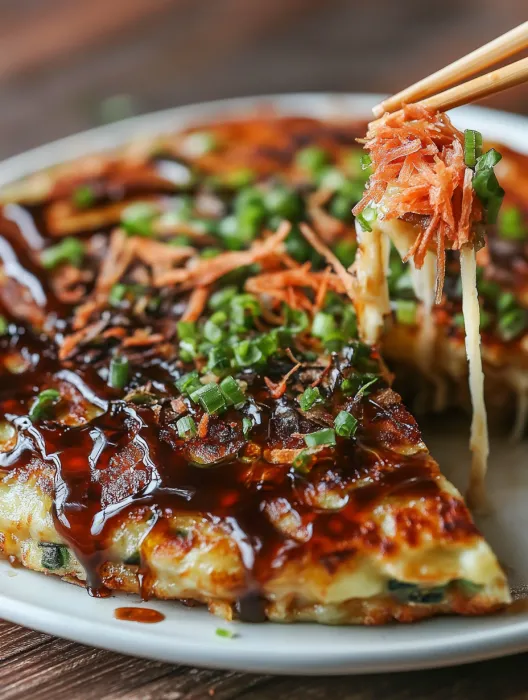 Highlight
Highlight
This savory Japanese pancake has been my culinary obsession since discovering it at an Osaka street food festival. Okonomiyaki literally means "grilled as you like it," allowing you to customize your perfect comfort food with various proteins and toppings. This authentic recipe captures the traditional Osaka-style version that balances fluffy texture with crispy edges and complex umami flavors.
I first made this for my skeptical family who had never tried Japanese cuisine beyond sushi. Now it's requested weekly as our "fun food night" where everyone gets to personalize their toppings.
Ingredients
- All purpose flour creates the perfect base for this savory pancake. Look for unbleached varieties for best flavor.
- Diamond Crystal kosher salt enhances all the flavors without making the batter taste salty.
- Sugar balances the savory elements with just a touch of sweetness.
- Baking powder gives a gentle lift for that perfect texture.
- Nagaimo mountain yam provides the characteristic sticky yet fluffy texture. Fresh is best but frozen can work in a pinch.
- Dashi broth infuses authentic Japanese umami throughout the batter. Homemade dashi creates the most authentic flavor.
- Green cabbage forms the bulk of the pancake. Choose firm heads with tight leaves for best texture.
- Pickled red ginger adds bright tangy pops of flavor. The authentic Japanese beni shoga variety has the perfect balance.
- Sliced pork belly offers rich savory flavor that crisps beautifully. Look for even slices with good fat distribution.
- Large eggs bind everything together while adding richness. Room temperature eggs incorporate more easily.
- Tenkasu tempura scraps provide delightful crunchy pockets throughout. These crispy bits make a huge difference in texture.
- Neutral oil prevents sticking and helps develop a beautiful crust. High smoke point oils like grapeseed work best.
Step-by-Step Instructions
- Create Base Batter
- Whisk together flour, salt, sugar and baking powder in a large bowl until evenly distributed. The careful measuring here builds the foundation for the perfect texture.
- Prepare Mountain Yam
- Peel and grate the nagaimo using a ceramic grater for finest texture. The mountain yam creates a slimy texture that might feel strange but is absolutely crucial for authentic okonomiyaki. Work quickly and rinse hands immediately after handling to prevent skin irritation.
- Mix Wet Ingredients
- Combine grated nagaimo with dashi broth in your flour mixture. Stir until just combined without overmixing. The batter will look slightly lumpy but should have no dry flour pockets. Allow to rest for at least one hour or ideally overnight for superior texture and flavor development.
- Prepare Cabbage
- Cut cabbage into very thin strips then mince finely. Proper cabbage preparation makes all the difference. Wash thoroughly then spin dry completely to prevent soggy pancakes. The cabbage should be dry enough that it doesn't release water when squeezed.
- Create Final Batter
- Fold eggs, tenkasu tempura bits, and pickled ginger into your rested base batter. Stir gently until just combined. Add minced cabbage in three batches, folding carefully after each addition until cabbage is evenly coated but not beaten down.
- Cook First Side
- Heat oiled pan to medium heat before adding a generous portion of batter. Shape into a circle about 6 inches in diameter and around 3/4 inch thick. Arrange pork belly slices decoratively on top. Cover and cook for exactly 5 minutes until the bottom develops a golden brown crust.
- Execute Perfect Flip
- Use two spatulas to gently flip the entire pancake. This critical moment requires confidence. In one swift motion, slide your primary spatula completely under the pancake and use the second spatula to guide the flip. Immediately press down gently to secure the shape.
- Finish Cooking
- Cook covered for another 5 minutes to ensure the pork is fully cooked and the batter is set throughout. Uncover and flip once more for the final 2 minutes to crisp the exterior to perfection. The finished okonomiyaki should have a springy center when pressed lightly.
- Apply Signature Toppings
- Brush the traditional sweet okonomiyaki sauce across the top surface. Drizzle Japanese Kewpie mayonnaise in a zigzag pattern. Create the signature design by dragging a chopstick through the mayo lines. Finish with a generous sprinkling of katsuobushi, aonori seaweed, and remaining pickled ginger.

The mountain yam might seem like an unusual ingredient but it transforms the texture completely. The first time I served this to my Japanese neighbor, she closed her eyes and said it transported her straight back to the streets of Osaka. That moment convinced me never to skip this crucial ingredient.
The Secret of Proper Batter Rest
The magic of okonomiyaki happens during the resting period. As the batter sits, the flour particles fully hydrate, gluten relaxes, and flavors deepen substantially. Professional okonomiyaki shops in Japan always prepare their batter a day ahead. If possible, mix your batter the night before cooking and refrigerate covered. You'll notice dramatically improved texture with a lighter, fluffier interior and more complex flavor profile.
Regional Variations Worth Trying
While this recipe follows the Osaka style which mixes all ingredients together, Hiroshima style creates distinct layers. To try this variation, make a thin crepe-like pancake first, then layer cabbage, bean sprouts, pork belly, and noodles on top before flipping. Tokyo versions often include grated mountain potato instead of nagaimo and add seafood. Each regional style offers a unique experience, but the Osaka style remains the most approachable for home cooks.
Serving Beyond Traditional
Though the classic toppings create the authentic experience, okonomiyaki welcomes creative variations. Try topping with crumbled bacon, shredded cheese, or spicy sriracha mayo for fusion options. For a complete meal, serve alongside a light miso soup and pickled cucumber salad to balance the richness. Many Japanese families enjoy okonomiyaki with cold beer or hot green tea which perfectly complements the savory flavors.
Storage Success
For perfect leftovers, cool completely before wrapping individual pancakes in foil without any sauce or toppings. When reheating refrigerated okonomiyaki, a toaster oven at 350°F for 10-15 minutes creates the best texture by maintaining the crispy exterior. For frozen pancakes, either thaw overnight in the refrigerator first or heat directly from frozen for 25-30 minutes. Add fresh toppings after reheating for the most authentic experience.

Common Questions About the Recipe
- → What is nagaimo and can I substitute it?
Nagaimo (mountain yam) is a Japanese root vegetable that adds a light, fluffy texture to okonomiyaki when grated. While it's a traditional ingredient, you can substitute with grated potato mixed with a bit of cornstarch if unavailable. However, the authentic texture is best achieved with nagaimo.
- → How do I flip okonomiyaki without breaking it?
For successful flipping, ensure your pancake is cooked enough on the bottom (about 5 minutes on medium-low heat), use a large spatula or two spatulas, and flip with confidence in one quick motion. Making smaller, thinner pancakes is easier for beginners. After flipping, gently press down to maintain the shape.
- → What protein options work well besides pork belly?
While traditional Osaka-style okonomiyaki uses thinly sliced pork belly, you can substitute with shrimp, squid, chicken, or for vegetarian options, use mushrooms, tofu, or just increase the vegetables. The name 'okonomiyaki' means 'grilled as you like it,' so customization is encouraged!
- → Can I make okonomiyaki ahead of time?
Yes! Okonomiyaki freezes surprisingly well. Cook the pancakes completely, let them cool, and wrap individually without toppings. They'll keep in the refrigerator for up to 3 days or in the freezer for a month. Reheat in a 350°F oven until hot, then add fresh toppings.
- → Is there a particular technique for getting the cabbage texture right?
For ideal texture, chop the cabbage into small pieces (about ½-inch), but not too fine. Washing and thoroughly drying the cabbage is crucial—excess moisture will make your pancake soggy. The cabbage should be well-coated with batter but still visible, giving the final pancake a light, crispy-yet-tender texture.
- → What are the essential toppings for authentic okonomiyaki?
Traditional toppings include okonomiyaki sauce (a sweet-savory sauce similar to Worcestershire), Japanese Kewpie mayonnaise drizzled in a zigzag pattern, katsuobushi (bonito flakes), aonori (dried seaweed flakes), and pickled red ginger. Green onions are also common. The combination of these toppings creates the distinctive flavor profile.
